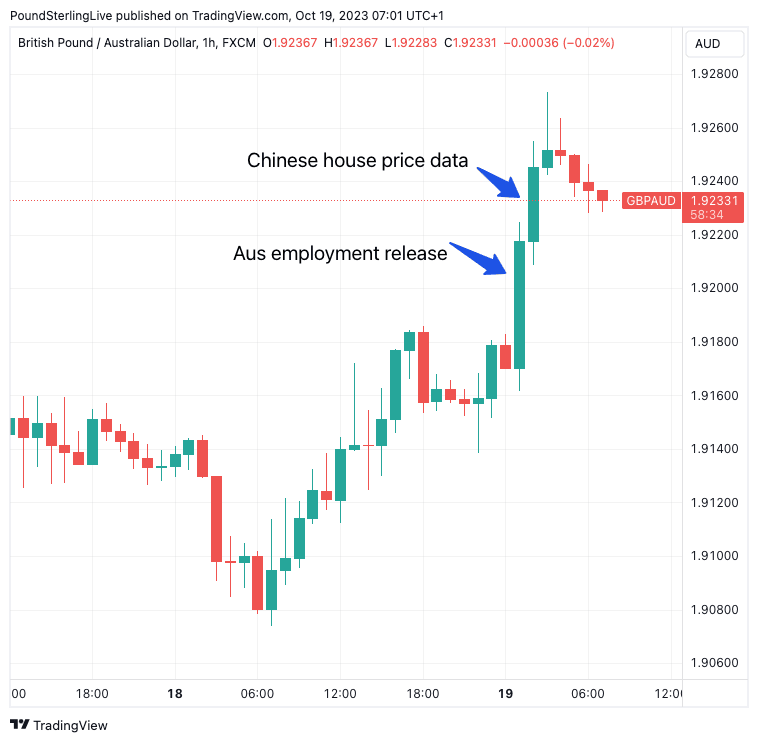Australian Dollar Heavy on Employment Miss and Risk-off Sentiment
- Written by: Sam Coventry
-

Image © Adobe Images
The Australian Dollar was an underperformer on October 19 after unexpectedly soft local employment data combined with fresh Chinese housing market concerns and surging U.S. bond yields.
Australia's employment figures printed at 6.7K in September, which was well below the 20K expected, hinting that the labour market might be 'loosening' and the Reserve Bank of Australia won't be required to raise interest rates again.
The unemployment rate slid to 3.6% which, on the face of it, is positive, but the participation rate unexpectedly fell to 66.7% in September, below both the consensus and August's 67%.
"The Australian labour market data should not be taken as a strong reading," says David Forrester, Senior FX Strategist at Crédit Agricole. "Labour force participation declined a large 0.2ppt. So, a decline in job seekers caused the decline in the unemployment rate."
"Given the slowdown in economic activity, which appears to have continued through the September quarter, yearly growth in employment and hours worked should cool materially over coming months," says Adam Boyton, Head of Australian Economics at ANZ.
However, ANZ and other leading Australian lenders say the next meeting of the RBA could yet result in an interest rate rise because the labour market remains tight overall.
But much will depend on next week's inflation data which will likely 'seal the deal'. Should the RBA surprise with a hike, the Aussie could catch a bid.
Markets are cautious on Australia's currency, though: the Pound to Australian Dollar exchange rate extended a recovery to quote at 1.9236 at the time of writing on Thursday, the Euro to Australian Dollar rallied half a per cent to 1.6720, the Australian Dollar to U.S. Dollar was 0.60% lower at 0.63.
Above: GBPAUD at one-hour intervals. Set up a daily rate alert email to track your exchange rate OR set an alert for when your ideal exchange rate is triggered ➡ find out more.
AUD came under further pressure after China released housing figures an hour after the domestic employment numbers.
China home prices fell at the fastest pace in almost a year in September, adding to doubts over whether Beijing’s steps to prop up the property market are enough to revive the sector.
New home prices declined 0.3% in the month to September, adding to a similar decline recorded in the prior month, sending a reminder the economy remains fragile.
The Australian Dollar is highly exposed to China, which is Australia's leading export destination, meaning the health of the world's second-largest economy matters.
It was reported midweek that Chinese GDP and industrial production data came in ahead of expectations, raising hopes that the worst was now behind the economy's slowdown.
The Australian Dollar benefited from this data, but the reversal seen through Thursday suggests the property sector could yet prove a drag.
The house price figures come in the wake of one of China's biggest developers - Country Garden Holdings - warning it was likely to default on a dollar bond for the first time.
"The September Chinese economic data indicates that the property sector is still weak and a drag on the economy. Alongside the looming default by Chinese property developer, Country Garden, sentiment around the property market is likely to remain weak for now," says Kristina Clifton, an analyst at Commonwealth Bank of Australia.
Pressure on AUD Extends Ahead of Key Powell Speech
Pressure on stocks and risk-linked assets extends into the European trading session with sentiment struggling amidst an ongoing surge in U.S. bond yields as investors prepare for the U.S. Federal Reserve to maintain interest rates at elevated levels for an extended period.
"Stock markets fell deeper into the red on Thursday after widespread losses yesterday on the back of the tense mood in the Middle East that has fanned the rally in crude oil, which in turn is pushing up soaring bond yields even higher," says Raffi Boyadjian, Lead Investment Analyst at XM.com.
The U.S. ten-year yield - the benchmark to watch - reached fresh cycle highs at 4.967%.
Markets now turn to a 17:00 BST speech from the Federal Reserve's Jerome Powell, and the AUD could come under pressure if he doubles down on a message that U.S. interest rates will stay higher for longer.
"We expect Powell to reiterate the FOMC view that another hike in the Funds rate this year is more likely than not. A reiteration of the 'higher for longer' message on interest rates may allow US yields to stay at or above their current levels and keep the USD supported," says Clifton.
Nevertheless, the rise in yields could prompt Powell into a more circumspect mood that might disappoint some USD bulls. Indeed, rising yields imply tightening financial conditions that aid the Fed's already-delivered interest rate hikes in cooling economic activity and inflation.
Should Powell reference these developments, the market might pare back expectations for a November rate hike, potentially offering the likes of the Australian Dollar some relief.











